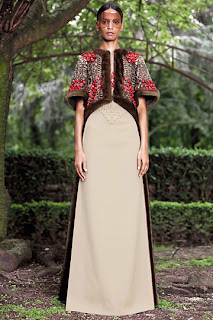Couture is something else.
It is in a sense the vestiges of a time when if you wanted to dress
well, you had a dress maker. You also would have a milliner, a glover and a
shoemaker. Now a days you may have each of these but increasingly a brand
will oversee your entire couture look from blush to belt buckles.
Elie Saab A/W 2012/2013 Couture. A personal favourite.
Images courtesy of Getty Images for Marie Claire Australia.
The beginning of couture as we know it today is attributed to Charles Frederick Worth (1826-1895) of the House of Worth, who from
his atelier in Paris made impossible to wear, ruinously expensive gowns that
were lusted after by European and American aristocracy for their beauty and individualism.
Gowns from the House of Worth, circa 1887(left) and 1898 - 1900 (right).
The House of Worth disappeared from the fashion scene for
decades until recently revived in 2011 for RTW and interestingly, lingerie.
Couture is literally the height of fashion. The costs of a
handmade couture piece – and they are all handmade by skilled ateliers – is out
of the reach of the 99% and always will be. You pay for uniqueness, immaculate design
and immaculate make. You pay for a piece that can be handed down for
generations and still be beautiful and lusted after.
The costs of couture are not held by the customer alone. To
make a couture collection is fantastically expensive for fashion house as well.
So much so that very few do and even those commonly associated with couture may
retreat from the field for a few years when finances bite and they can’t afford
to make the gowns and put on the show, let alone service the demanding
customers that couture attracts.
All that impracticality aside, couture is about beautiful clothes that if you are lucky enough to wear them, transform you and the way you look and feel. So here is a bit of a wrap up from a few websites on the
couture shows and a little bit of street style.
If you wanted to know more about the history of couture, go out and buy yourself The Golden Age of Couture, a V&A publication. Full of stunning photos and illustrations, it's a wonderful read.
Armani Prive. Image courtesy of Harpers Bazaar Australia.
Chanel. Image courtesy of Harpers Bazaar Australia
Christian Dior. Image courtesy of Style Hunter.
Elie Saab. Image courtesy of Getty Images for Marie Claire Australia.
Givency. Image courtesy of New York Mag.
Jean Paul Gaultier. Image courtesy of Getty Images for Marie Claire Australia.
Valentino. Image courtesy of Getty Images for Marie Claire Australia.
Versace. Image courtesy of New York Mag.












No comments:
Post a Comment